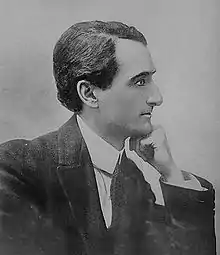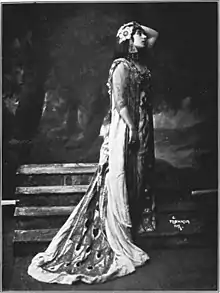L'amore dei tre re
L'amore dei tre re ("The Love of the Three Kings") is an opera in three acts by Italo Montemezzi. Its Italian-language libretto was written by playwright Sem Benelli who based it on his play of the same title.
| Italo Montemezzi |
|---|
 |
Performance history
The opera premiered at La Scala in Milan on 10 April 1913. It received mixed reviews, but quickly became an international success, especially in the United States, where it became a staple of the repertory for several decades.[1] After the Second World War, the frequency of performances declined dramatically, and it was not performed in the US for nearly 30 years. It is still performed only rarely.[2]
Roles
| Role | Voice type | Premiere cast, 10 April 1913[3] Conductor: Tullio Serafin |
|---|---|---|
| Archibaldo, King of Altura | bass | Nazzareno De Angelis |
| Manfredo, his son | baritone | Carlo Galeffi |
| Fiora, Manfredo's wife | soprano | Luisa Villani |
| Avito, former Prince of Altura | tenor | Edoardo Ferrari-Fontana |
| Flaminio, a castle guard | tenor | Giordano Paltrinieri |
| A Handmaiden | soprano | Fernanda Guelpi |
| A Young Woman | soprano | Enrica Merli |
| A Youth | tenor | Cesare Spadoni |
| An Old Woman | mezzo-soprano | Rosa Garavaglia |
| An Offstage Voice | boy soprano | |
| People of Altura | ||
Synopsis

- Time: The Dark Ages
- Place: Italy
Archibaldo, the blind king, conquered the kingdom of Altura forty years before the opera begins. After forty years, the Alturan people openly object to the reign of the Germanic Archibaldo. Archibaldo recounts his memories of the thrill of conquest, and his reminiscence equates the invasion of Italy to the winning of a beautiful woman.
The story unfolds as we learn that Archibaldo's son Manfredo has been married to the native Alturan princess Fiora. But Fiora is having an affair with another Alturan prince, Avito. Although Archibaldo suspects Fiora of infidelity, he falls short of proof, since he is blind, and his own Alturan servants do not cooperate with him in uncovering the affair.
In the first two acts there are various scenarios played out with mounting intensity. There are two love duets between Avito and Fiora, and a scene in which Manfredo pours out his love for Fiora and begs her to show him affection. All of these are interspersed with scenes in which Archibaldo questions Fiora. Finally, enraged, Archibaldo strangles her at the end of the second act.
In the final act, Fiora's body is laid in a crypt, and the people of Altura mourn for her. Archibaldo has secretly poisoned Fiora's lips, so that her lover will die. Avito kisses Fiora's lips. As he dies from the poison, Avito reveals to Manfredo that he was Fiora's lover, and that Archibaldo has laid the poison. Stricken with grief at the loss of the woman he loved, Manfredo also kisses Fiora's lips. Finally, Archibaldo enters to see if his trap has caught Fiora's lover, and despairs as he hears the voice of his dying son.[4]
Music
The music of the opera is lush and complex. Similar to works such as Debussy's Pelléas et Mélisande, the orchestra frequently reveals the subtext of the interactions between the characters. Montemezzi himself held that Archibaldo is not only suspicious of Fiora, but also desires her himself.[5] The orchestration, in surges of rich density, also marks how characters move into states of very deep passion. When the characters are moved into these states, the music has a very distinct, transcendent and dreamlike quality.
Recordings
- 1941 – Grace Moore, Charles Kullman, Richard Bonelli, Ezio Pinza,[6] New York MET, Italo Montemezzi – (Eklipse, 15 February 1941)
- 1951 – Clara Petrella, Amedeo Berdini, Renato Capecchi, Sesto Bruscantini, Milan RAI Lyric Orchestra, Arturo Basile – (Cetra, 1951)
- 1969 – Luisa Malagrida, Pierre Duval, Enzo Sordello, Ezio Flagello, Coro e Orchestra Sinfonica di Roma, Richard Karp – (Delphi, 1969)
- 1977 – Anna Moffo, Plácido Domingo, Pablo Elvira, Cesare Siepi, Ryland Davies, Ambrosian Opera Chorus, London Symphony Orchestra, Nello Santi – (RCA 1977)
- 1973 – Ileana Meriggioli, Pedro Lavitgen, Attilio D'Orazi, Dimiter Petkov. L'Orchestra e Coro Gran Teatro del Liceo Barcelona, Ivo Savini, 24 November 1973 (Arkadia HO 607.2)
- 1974 – Virginia Zeani, Ennio Buoso, Giulio Fioravanti, Nicola Rossi-Lemeni Orcestea e Coro della RAI Milano, Maurizio Arena, 28 March 1974 (House of Opera New York)
References
- "Repertory Report", Metropolitan Opera
- Search: L'amore dei tre re: 66 performances, last on January 15, 1949
- Casaglia, Gherardo (2005)."L´amore dei tre re, 10 April 1913". L'Almanacco di Gherardo Casaglia (in Italian).
- For a detailed synopsis see Benelli, Sem (1913). L'amore dei tre re, tragic poem in 3 acts (libretto in the original Italian with an English translation and synopsis by R. H. Elkin). G. Ricordi & Co. pp. 1–2.
- David Chandler, "Italo Montemezzi and the Conquest of America" on musicweb-international.com. Retrieved 3 April 2013
-
- Metropolitan Opera Archives. Performance record: Pinza, Ezio (Bass). Accessed 19 April 2011.
Further reading
- Aldrich, Richard (14 February 1915). "The Reappearance of Montemezzi's Opera, L'Amore dei tre re – Some Merits of Its Originality". The New York Times. Accessed 19 April 2011.
- The New York Times (9 November 1916). "Love of Three Kings Sung, Riccardo Martin and Luisa Villani in Montemezzi's Opera". Accessed 19 April 2011.
- Fifield, Christopher (December 2001). Recording review: L'amore Dei Tre Re (1950), Warner Fonit 8573 874787. MusicWeb International. Accessed 19 April 2011.
- Grout, Donald Jay and Williams, Hermine Weigel (2003). A Short History of Opera, 4th edition. Columbia University Press. ISBN 0-231-11958-5
- Jell, George Clarence (1933). Master Builders of Opera. Ayer Publishing (reprint). ISBN 0-8369-1964-5
- Mallach, Alan (2007). The Autumn of Italian Opera: From Verismo to Modernism, 1890–1915. Northeastern University Press. ISBN 1-55553-683-2
- Shoemaker, Paul (May 2003). "Recording review: L'amore Dei Tre Re (1941), Guild GHCD 2234–5. MusicWeb International. Accessed 19 April 2011.
- Metropolitan Opera Archives. L'amore dei tre re, US premiere, 2 January 1914. Accessed 19 April 2011.
External links
- L'amore dei tre re: Scores at the International Music Score Library Project
- Review of the 2006 revival by the Opera Orchestra of New York, operatoday.com